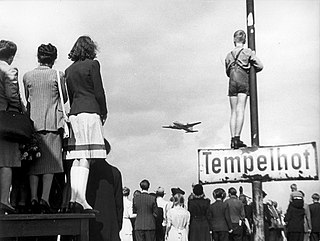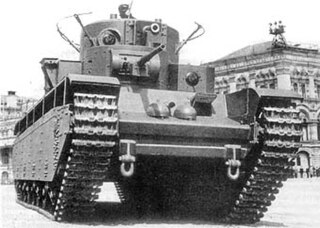
The T-35 was a Soviet multi-turreted heavy tank of the interwar period and early Second World War that saw limited production and service with the Red Army. Often called a land battleship, it was the only five-turreted heavy tank in the world to reach production, but proved to be slow and mechanically unreliable. Most of the T-35 tanks still operational at the time of Operation Barbarossa were lost due to mechanical failure rather than enemy action.

Panzerkampfwagen VIII Maus ("Mouse") was a German World War II super-heavy tank completed in late 1944. It is the heaviest fully enclosed armoured fighting vehicle ever built. Five were ordered, but only two hulls and one turret were completed before the testing grounds were captured by advancing Soviet military forces.

The Leopard 2 is a main battle tank developed by Krauss-Maffei in the 1970s for the West German Army. The tank first entered service in 1979 and succeeded the earlier Leopard 1 as the main battle tank of the German Army. It is armed with a 120 mm smoothbore cannon, and is powered by a V-12 twin-turbo diesel engine. Various versions have served in the armed forces of Germany and 12 other European countries, as well as several non-European nations, including Canada, Chile, Indonesia, Singapore, and Turkey. The Leopard 2 was used in Kosovo with the German Army, and has seen action in Afghanistan with the Dutch, Danish and Canadian contributions to the International Security Assistance Force, as well as also seeing action in Syria with the Turkish Armed Forces against ISIS and the YPG.

The term Schwerer Panzerspähwagen, covers the 6 and 8 wheeled armoured cars Germany used during the Second World War.
The Admiralty Pier Turret or Dover Turret, is an enclosed armoured turret built in 1882 on the western breakwater of Dover Harbour in southeast England. It contains two Fraser RML 16 inch 80 ton guns, the biggest installed in the United Kingdom. Declared obsolete in 1902, it is currently part of the port and inaccessible, though the guns remain in place.
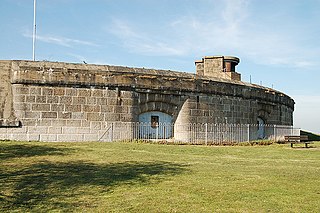
Coalhouse Fort is an artillery fort in the eastern English county of Essex. It was built in the 1860s to guard the lower Thames from seaborne attack. It stands at Coalhouse Point on the north bank of the river, at a location near East Tilbury that was vulnerable to raiders and invaders. It was the last in a series of fortifications dating back to the 15th century and was the direct successor to a smaller mid-19th century fort built on the same site. Constructed during a period of tension with France, its location on marshy ground caused problems from the start and led to a lengthy construction process. The fort was equipped with a variety of large-calibre artillery guns and the most modern defensive facilities of the time, including shell-proof casemates protected by granite facing and cast-iron shields. Its lengthy construction and the rapid pace of artillery development at the time meant that it was practically obsolete for its original purpose within a few years of its completion.

Barbettes are several types of gun emplacement in terrestrial fortifications or on naval ships.

Jean Bart was a French battleship of World War II, named for the 17th-century seaman, privateer, and corsair Jean Bart. She was the second Richelieu-class battleship. Derived from the Dunkerque class, Jean Bart were designed to fight the new battleships of the Italian Navy. Their speed, shielding, armament, and overall technology were state of the art, but they had a rather unusual main battery armament arrangement, with two 4-gun turrets forward and none aft.
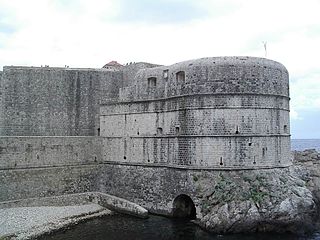
A casemate is a fortified gun emplacement or armored structure from which guns are fired. Originally, the term referred to a vaulted chamber in a fortress. In armoured fighting vehicles that do not have a turret for the main gun, the structure that accommodates the gun is termed the casemate.

Suffren was a pre-dreadnought battleship of the French Navy, launched in July 1899. She was named after French Vice Admiral Pierre André de Suffren de Saint Tropez. The ship was originally intended to be a modified version of the Iéna design with more firepower and better armour. Before World War I Suffren had an eventful career as she twice collided with French ships and twice had propeller shafts break. She was quickly sent to the Dardanelles after the beginning of the war to reinforce British forces already there.

A gun turret is a location from which weapons can be fired that affords protection, visibility, and some cone of fire. A modern gun turret is generally a weapon mount that houses the crew or mechanism of a projectile-firing weapon and at the same time lets the weapon be aimed and fired in some degree of azimuth and elevation.

Several boards have been appointed by US presidents or Congress to evaluate the US defensive fortifications, primarily coastal defenses near strategically important harbors on the US shores, its territories, and its protectorates.

The United States provided tens of thousands of its Medium Tank M4, also named the Sherman, to many of its Allies during the Second World War, under the terms of Lend-Lease.

A disappearing gun, a gun mounted on a disappearing carriage, is an obsolete type of artillery which enabled a gun to hide from direct fire and observation. The overwhelming majority of carriage designs enabled the gun to rotate backwards and down behind a parapet, or into a pit protected by a wall after it was fired; a small number were simply barbette mounts on a retractable platform. Either way, retraction lowered the gun from view and direct fire by the enemy while it was being reloaded. It also made reloading easier, since it lowered the breech to a level just above the loading platform, and shells could be rolled right up to the open breech for loading and ramming. Other benefits over non-disappearing types were a higher rate of repetitive fire and less fatigue for the gun crew.

The Dragoon 300 AFV was produced by Arrowpointe Corporation during the 1980s. It was based on the automotive components of the US Army's M113 APCs and 5 ton trucks. It resembled a larger V-150 Commando.

100 56 TK or 100 TK is a Finnish stationary coastal artillery gun that utilizes the tank turret from the Soviet T-55 tank with its 100 mm D-10 tank gun. 100 56 TK was the main light weapon of the Finnish coastal artillery and complemented the medium gun 130 TK in the coastal artillery role until its decommissioning in 2012.

Gaulois was a Charlemagne-class pre-dreadnought battleship built for the French Navy in the mid-1890s. She spent most of her career assigned to the Mediterranean Squadron. The ship accidentally rammed two other French warships early in her career, although neither was seriously damaged, nor was the ship herself.

The Séré de Rivières system was named after Raymond Adolphe Séré de Rivières, its originator. The system was an ensemble of fortifications built from 1874 along the frontiers and coasts of France. The fortresses were obsolescent by 1914 but were still used during the First World War.

Culver Battery is a former coastal artillery battery on Culver Down, on the eastern side of the Isle of Wight. The fortification is one of several Palmerston Forts built on the island following concerns about the size and strength of the French Navy in the late 19th century. It was operational during the First and Second World Wars. The battery was closed in 1956.
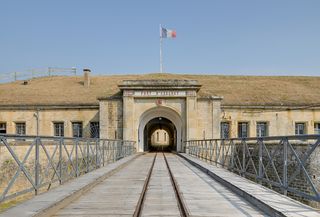
The Fort d'Uxegney, or Fort Roussel, is part of the fortifications of Épinal. It was built near the village of Uxegney between 1882 and 1884, and was modernized in 1910. It is an example of a Séré de Rivières system fortification. It retains its armament and is maintained as a museum.




















